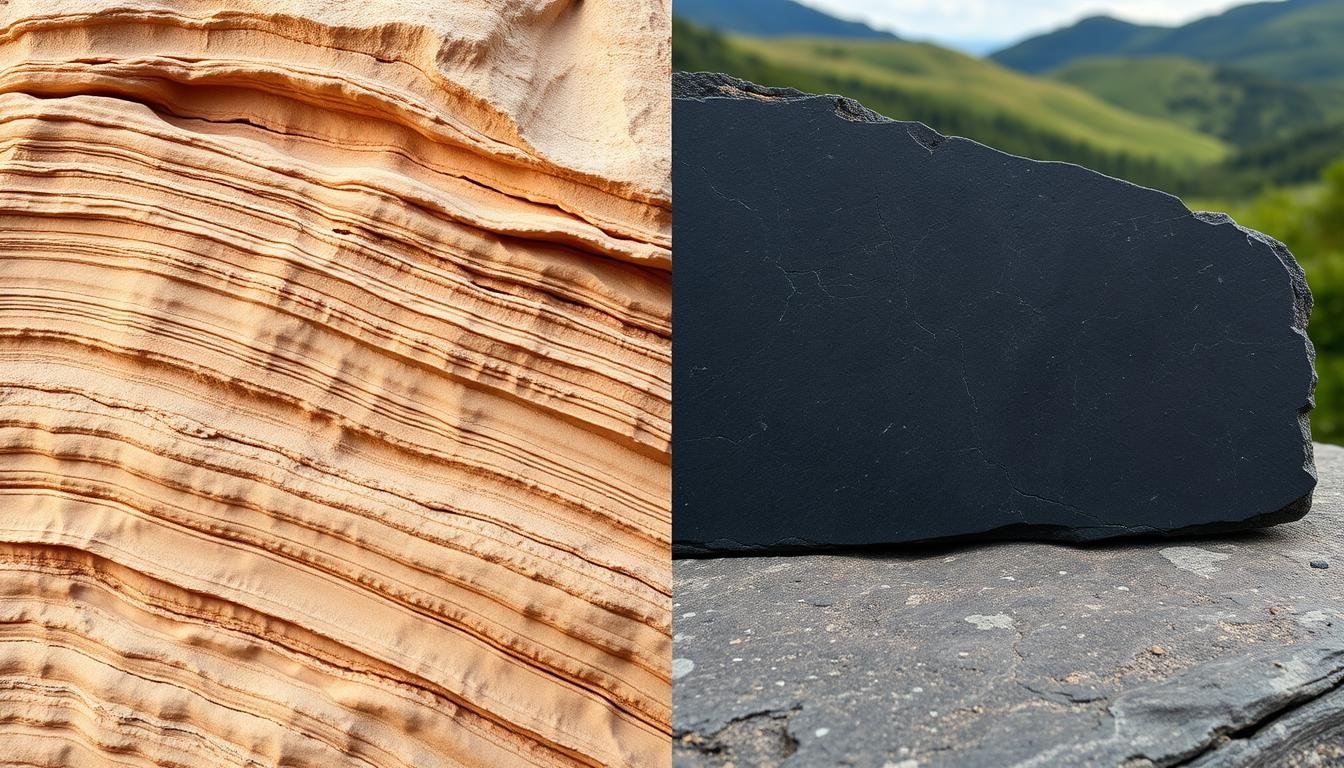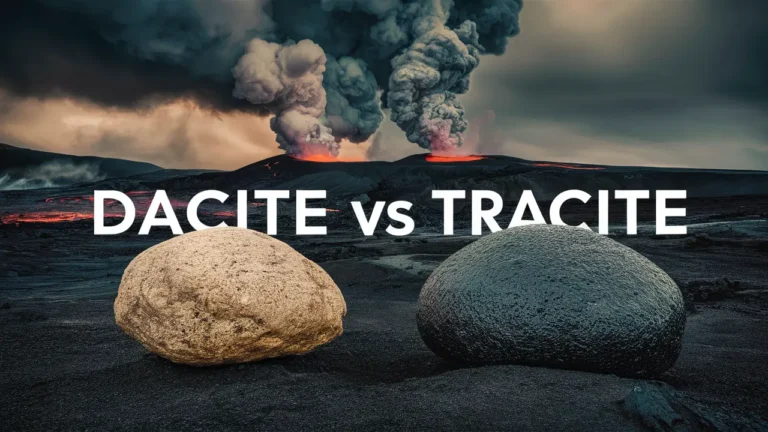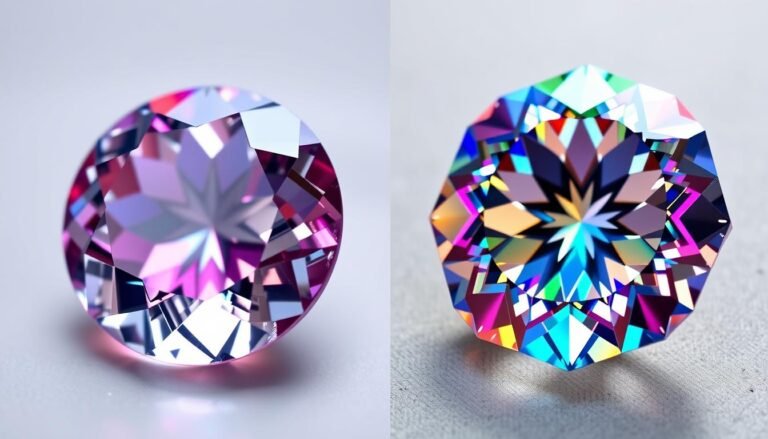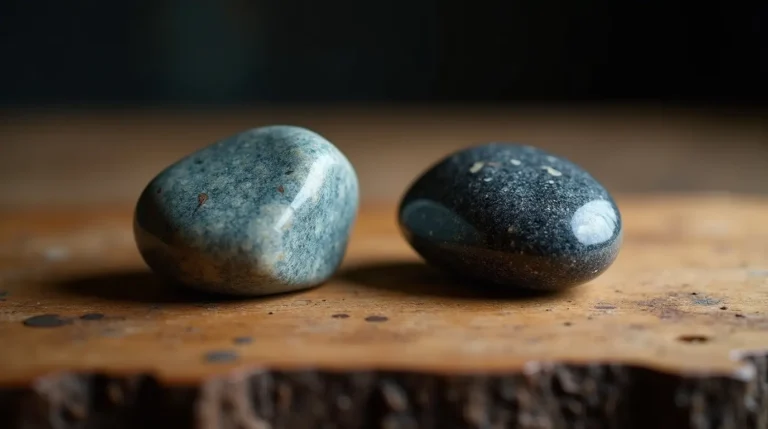Did you know a single storm can load a river with half its yearly sediment? This shows how important sedimentary rocks like shale and slate are. They’ve helped humans for centuries, used in building and art.
Exploring shale and slate reveals their unique qualities. These rocks differ in minerals and uses. Knowing the differences helps us use them better. Let’s dive into their history, how they form, and their uses today.
Introduction to Shale and Slate
Defining Shale and Slate
Shale and slate are two different types of rocks. Shale is made from silt and clay particles that are pressed together. Slate, on the other hand, starts as shale but is changed by heat and pressure into a new rock.
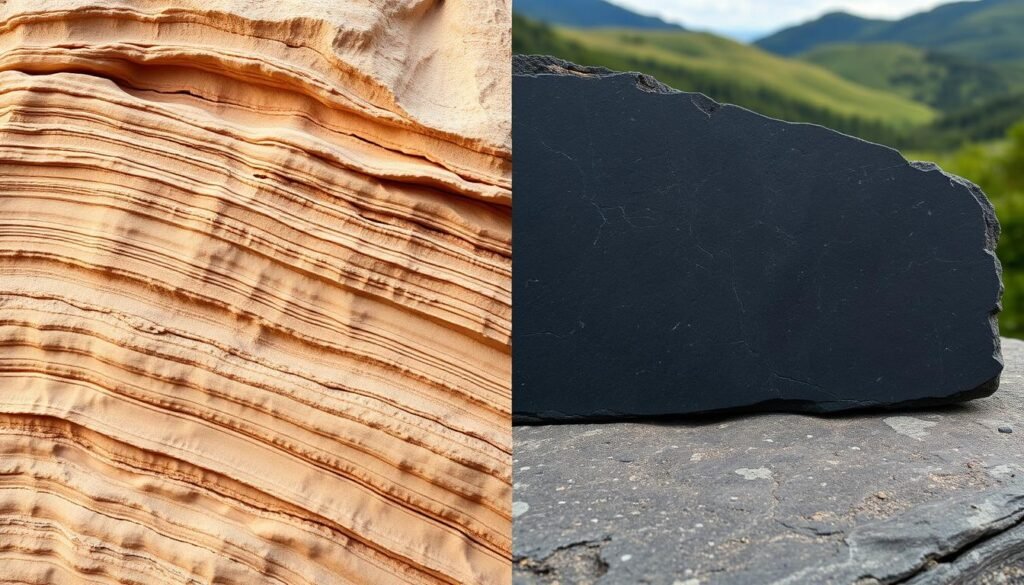
Historical Use and Importance
Both shale and slate have been used for a long time. Slate is great for roofs, floors, and walls. It’s also used for writing tablets, tombstones, and other items.
Shale, meanwhile, is a key source of oil and minerals. It’s also used to make cement and gravel for building.
These rocks have been crucial in human history. Their special qualities make them valuable for many uses. Knowing about shale and slate helps us see their importance today.
| Rock Type | Definition | Formation | Historical Uses |
|---|---|---|---|
| Shale | Fine-grained sedimentary rock composed of silt and clay-size mineral particles | Formed by the compaction and cementation of mud, silt, and clay deposits | Source of petroleum and other minerals, production of cement and construction aggregate |
| Slate | Fine-grained, foliated, homogeneous metamorphic rock derived from shale-type sedimentary rock | Formed through low-grade regional metamorphism of shale | Roofing, flooring, building stone, writing tablets, tombstones, and other household items |

Formation and Composition
How Shale and Slate are Formed
Shale forms from fine-grained sediments like clay and silt in quiet places like the ocean floor. These sediments get compacted and harden over time. This creates shale’s unique layered structure.
Slate, however, is a metamorphic rock. It forms when shale undergoes low-grade metamorphism. This process involves heat and pressure, making the minerals align and form layers. This transformation makes slate denser and more durable than shale.
Mineral and Compound Content
The minerals in shale and slate depend on the original sediments and metamorphism. Shale has minerals like clay, quartz, and organic matter. Slate is mainly made of mica, chlorite, and quartz.
The minerals in shale and slate affect their properties like hardness and color. Knowing how these rocks form and what minerals they have is key for identifying and using them.
| Characteristic | Shale | Slate |
|---|---|---|
| Predominant Minerals | Clay minerals, quartz, carbonates, feldspars, iron oxides, organic matter | Mica, chlorite, quartz |
| Formation Process | Deposition and compaction of fine-grained sediments | Low-grade regional metamorphism of shale |
| Geological Classification | Sedimentary rock | Metamorphic rock |
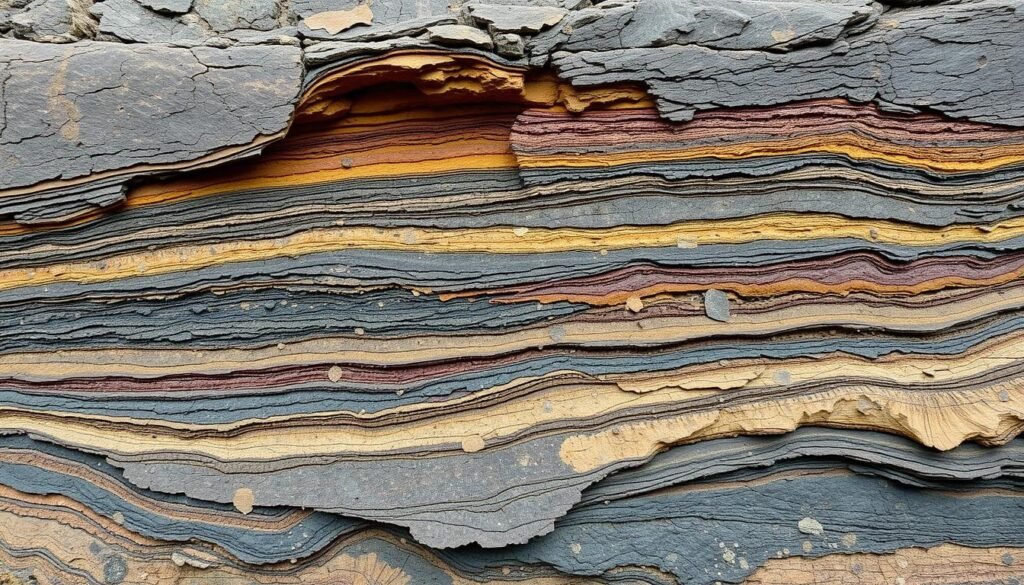
Shale vs Slate
Shale and slate are both sedimentary and metamorphic rocks, but they differ in many ways. Knowing the differences between them is important for many uses, like building materials and art.
Texture and Appearance
Shale has a rough, splintery texture and looks dull and earthy. Slate, on the other hand, has a smooth, uniform look. It also has a shiny metallic sheen that shale lacks.
Hardness and Porosity
Slate is harder and less porous than shale. The process that turns shale into slate makes it denser and harder. This makes slate great for roofing because it can be split into thin sheets.
Color Variations
Shale can be many colors, like black, gray, red, yellow, and green. Slate is usually gray, blue, or green, depending on what minerals it has.
The differences in appearance and properties come from how they are formed. Slate goes through more intense changes than shale.
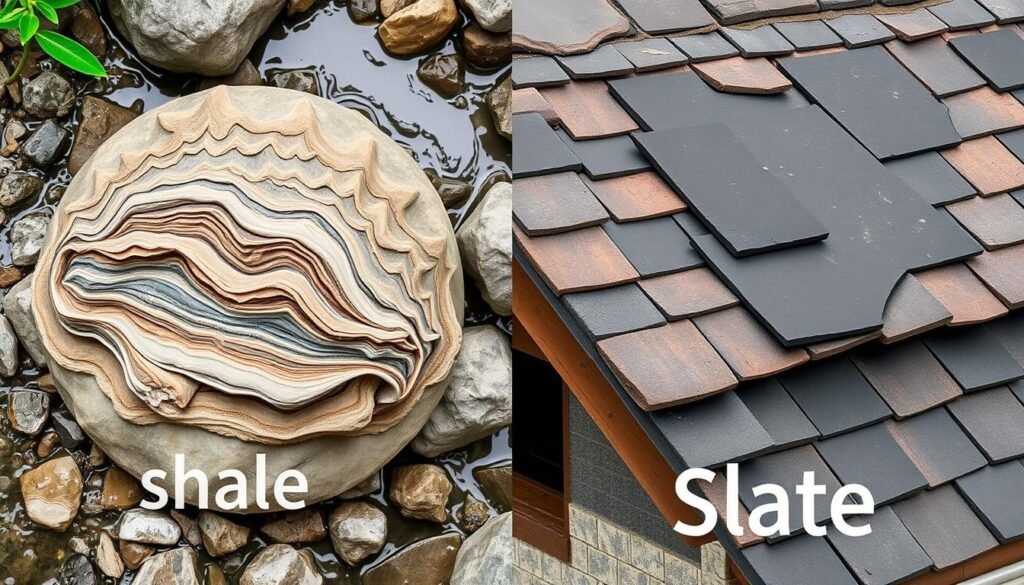
Physical Properties
Shale and slate have unique physical properties. These properties make them different and useful in various ways. Knowing these differences helps us understand and value their uses.
Hardness, Grain Size, and Fracture
Shale is harder than slate, with a Mohs hardness of 3-4. Slate is slightly softer, ranging from 1-7. This makes slate more durable and less prone to wear.
Shale and slate are both fine-grained, but they look different. Shale has a splintery texture, while slate is foliated. Shale breaks along bedding planes, and slate breaks along cleavage planes.
Color, Luster, and Porosity
Shale and slate come in many colors, like black, gray, red, yellow, and green. Shale looks dull and muddy, while slate has a dull, opaque shine.
Shale is more porous than slate. This allows it to absorb and release organic matter and minerals better. Shale’s porosity makes it great for construction and natural cement production.
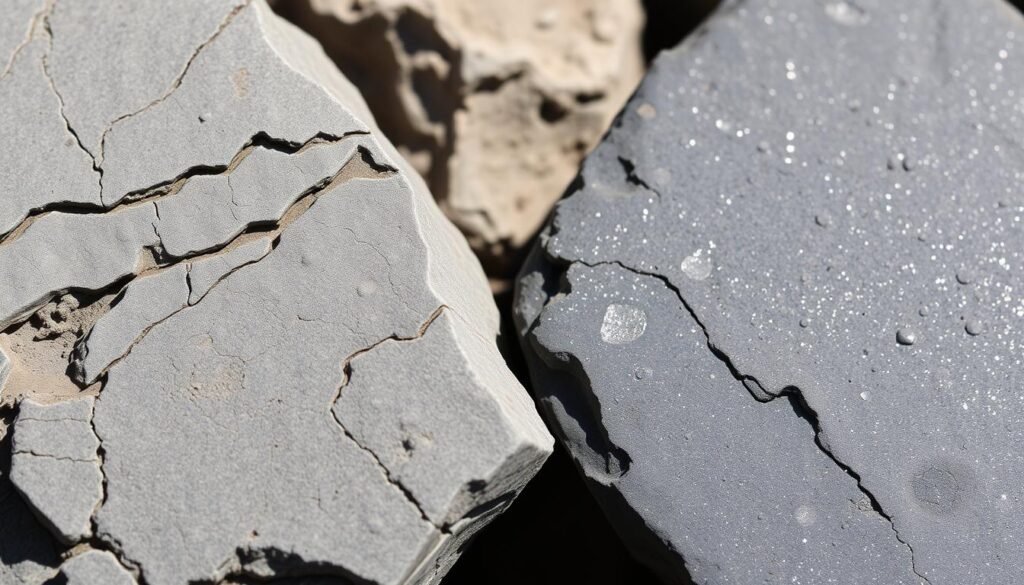
Thermal and Mechanical Properties
Shale and slate are two different types of sedimentary rocks. They have unique thermal and mechanical properties. These properties help decide how well these rocks work for different uses.
Thermal properties show how well rocks handle heat. Slate is better at conducting heat than shale. For example, slate’s heat-conductivity is higher than shale’s. This makes slate more useful in certain situations.
Looking at mechanical properties, slate is stronger and lasts longer than shale. Slate is better at handling pressure and wear. It also resists water, scratches, stains, and acid better than shale.
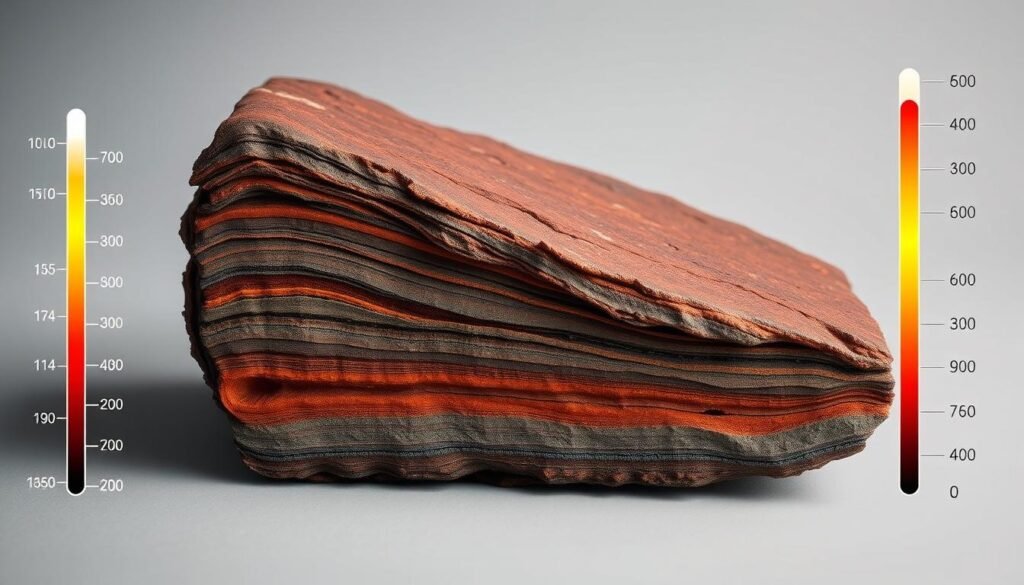
In short, shale and slate have different properties like heat-conductivity and strength. Slate’s better performance makes it more popular in building and industry.
Architectural and Industrial Applications
Shale and slate are used in many ways in architecture and industry. They show their value and versatility as building materials.
Interior and Exterior Building Uses
Slate is a favorite for many architectural needs, inside and out. It’s often used for roofs, floors, and decorations in buildings. Its strength, weather resistance, and beauty make it a top choice.
Shale, though less common, is used in building, facing, and making cement and other materials.
Construction and Industrial Utilization
Shale and slate are also used in industrial processes. Shale helps make cement and is used in construction. Slate is great for billiard tables, lab benches, and more, needing a tough, smooth surface.
Slate can last over a century, with some lasting up to two centuries, a British report says. It’s also good against fire, cold, and mold, making it easy to care for and green.

Slate’s versatility, strength, and beauty make it a key player in architecture and industry. It’s a valuable and essential material for many uses.
Antiquity and Artistic Significance
Shale and slate have been loved for their unique qualities and uses in art and culture. These rocks have been used in many monuments, sculptures, and small items. They show their lasting importance in ancient times.
Monuments, Sculptures, and Artifacts
Shale and slate are great for making lasting monuments and sculptures. They were used in ancient Egyptian obelisks and Grecian statues. These works of art have amazed people for centuries.
Smaller items like writing tablets and decorative figurines also show their wide use. They were found in digs all over the world. This proves they were important in daily life and for ceremonies.
Shale and slate were not just for big projects. They were also used for everyday items like roof tiles and floor slabs. And for fancy things like jewelry and ceremonial objects. Their strength and beauty made them key for ancient cultures.
| Artifact Type | Shale Historical Examples | Slate Historical Examples |
|---|---|---|
| Monuments | Egyptian obelisks, Chinese pagodas | Greek temples, Roman aqueducts |
| Sculptures | Sumerian statues, Mayan stelae | Grecian statues, Inuit carvings |
| Artifacts | Mesopotamian writing tablets, Chinese ink stones | Roman roof tiles, Welsh slate pencils |
Shale and slate’s lasting role in art and culture shows their timeless beauty. They were used in everything from big monuments to everyday items. Their impact on art is still felt today.
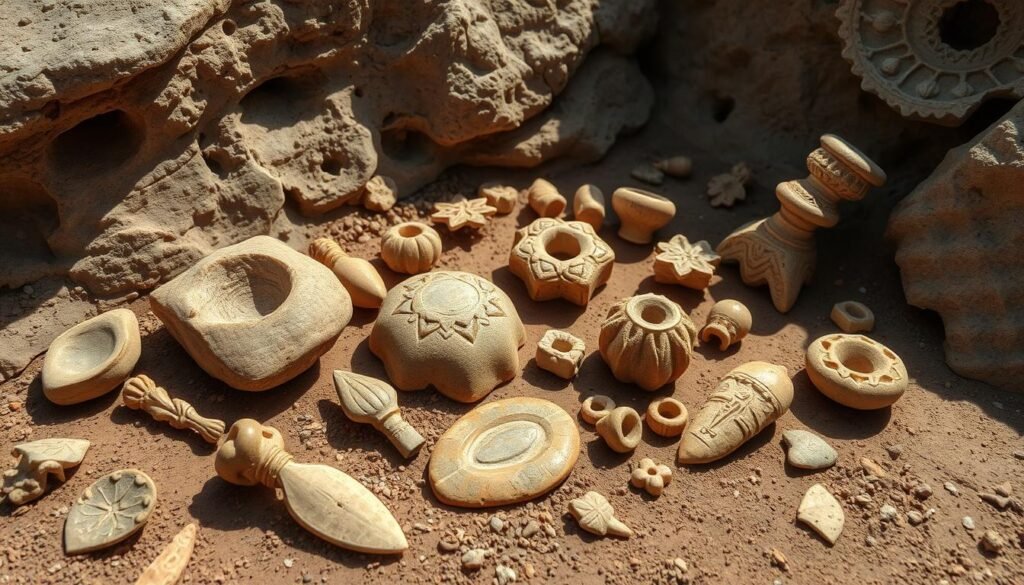
Geological Reserves and Deposits
Shale and slate deposits are found all over the world. Shale, a layered rock, is common in Asia, Africa, Europe, North America, and South America. Major deposits are in the United States, Russia, China, and India.
Slate, a durable rock, is mainly found in Europe, especially in the UK, France, and Spain. North America and Asia also have slate deposits. Spain has the biggest slate reserves, with 90% of the world’s slate used in construction coming from there.
Global Distribution and Locations
The age of these deposits varies worldwide. For example, Scotland’s Ballachulish slate is about 700 million years old. Spain’s slate from Orense is 450 million years old and metamorphosed 300-350 million years ago.
Other notable locations include:
- Brazil, where 95% of the country’s slate comes from the state of Minas Gerais
- China, the United Kingdom (specifically Wales), the United States (Terranova, Vermont, New York, and Virginia), and Brazil, which all have significant slate outcrops
- The Latrobe Gold Nugget, a rare cubic form of native gold weighing 717 grams, showcasing the unique geological formations found in certain regions
| Country | Shale Deposits | Slate Deposits |
|---|---|---|
| United States | Widespread across the country | Concentrated in Terranova, Vermont, New York, and Virginia |
| Russia | Significant deposits | Limited deposits |
| China | Extensive deposits | Notable deposits |
| Spain | Moderate deposits | Largest reserves of tectonic slate in the world |
| Brazil | Moderate deposits | 95% of the country’s slate comes from the state of Minas Gerais |
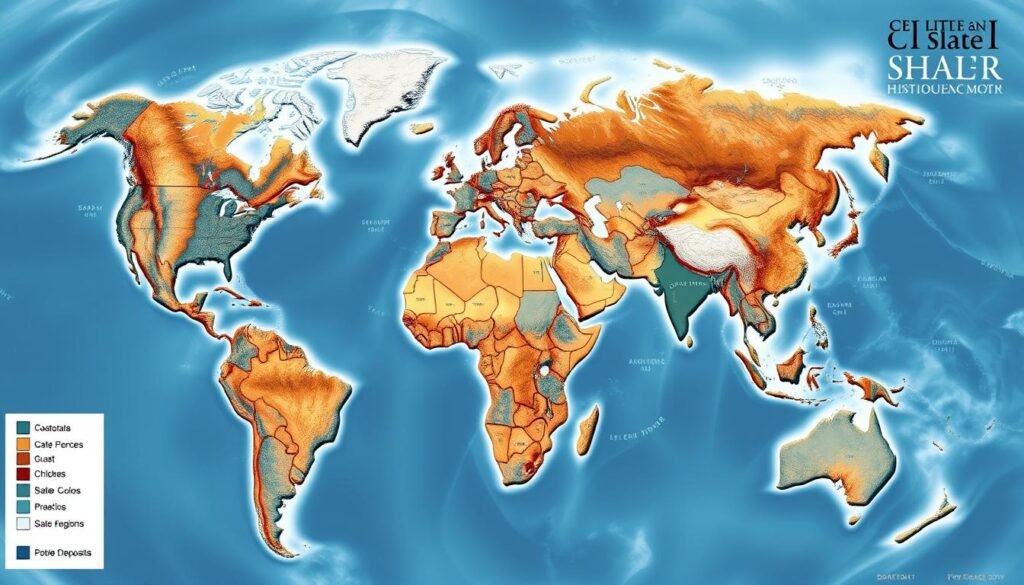
Environmental Impact and Sustainability
Extracting and using shale and slate can harm the environment. Shale, in particular, raises concerns about hydraulic fracturing. This method can affect water and local ecosystems. Yet, both materials can be used sustainably with careful extraction and recycling.
In 2023, the shale, clay, and slate industry grew to 3.175 million tons. This shows the need for environmental care in the industry.
The industry has always cared about the environment. The Expanded Shale, Clay, and Slate Institute (ESCSI) has worked on sustainability since the 1990s. They update Life-Cycle Inventory (LCI) studies to improve environmental performance. They also work with UL to create environmental product declarations (EPDs).
Expanded shale, clay, and slate (ESCS) materials are great for modern cities. They help with green roofs and urban landscaping. ESCS holds water well, reducing runoff and saving costs in construction.
The ESCS production process is low-energy, aiming to reduce environmental harm. This shows the industry’s dedication to sustainability through LCI studies and EPDs.
Real-world examples show ESCS’s benefits. Waterloo Park in Austin, Texas, uses ESCS for stormwater management. Historic Live Oaks in New Orleans use it to improve soil. The green roof at Ponce City Market in Atlanta, Georgia, uses ESCS for a lightweight growing medium.
In conclusion, the shale and slate industries are working towards sustainability. They use these materials to solve urban problems while reducing environmental harm. With responsible extraction and recycling, they are key to a greener future.
Metamorphism and Weathering Processes
Understanding the geological history of shale and slate is key. Metamorphism and weathering are crucial processes. They shape the characteristics and uses of these rocks.
Types of Metamorphism and Weathering
Shale turns into slate through low-grade regional metamorphism. This change happens due to heat and pressure. It creates slate’s unique foliated structure.
Shale and slate face different types of weathering. Biological weathering, like lichens and plants, breaks them down. Chemical weathering, where minerals react with water and air, also changes them. Mechanical weathering, like freeze-thaw cycles and erosion, plays a role too.
| Metamorphism Process | Weathering Process |
|---|---|
|
|
Metamorphism and weathering are vital to understanding shale and slate. They influence the unique properties and uses of these rocks.
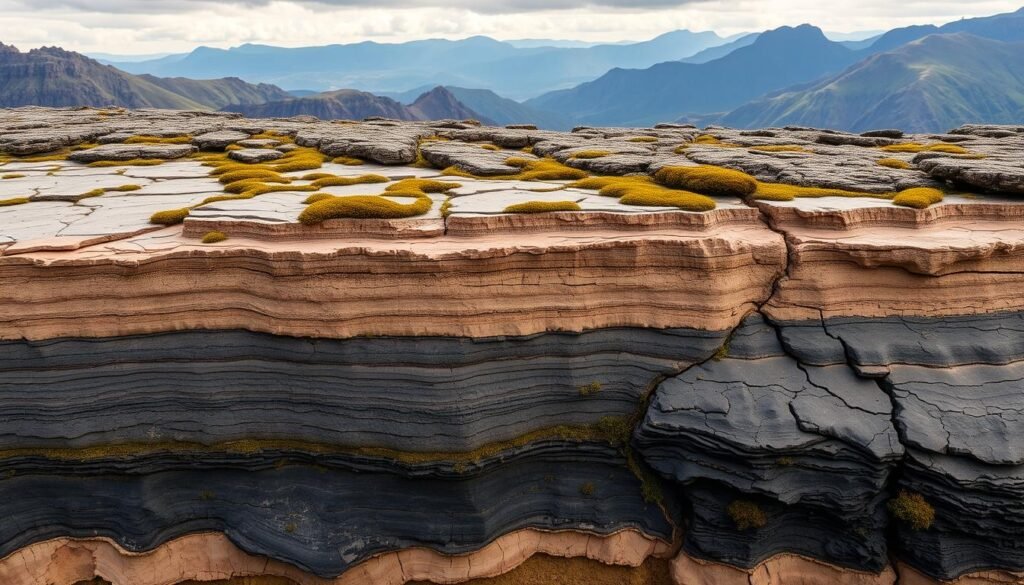
Economic Importance and Resource Extraction
Shale and slate are very valuable, used in many ways. Shale is key for oil and gas, known as “oil shale.” It’s used for energy. Slate is great for building and making things, helping many industries.
Getting these resources is key for our needs. They help meet demands for building stuff, energy, and more.
Oil Shale and Mineral Mining
Shale is mainly important for oil and gas. Oil shale, full of kerogen, can make fuels like gasoline and diesel. It’s also used for natural gas.
This method is getting more attention. It’s about finding new energy sources and using less traditional oil.
Shale and slate also have minerals like clays and metals. These are used in building and making things. This adds to their value.
| Mineral | Use |
|---|---|
| Clay | Ceramics, Bricks, Tiles, Cement |
| Aluminum | Aluminum Production, Alloys |
| Iron | Steel Production, Construction |
| Uranium | Nuclear Fuel, Medical Isotopes |
Using shale and slate is vital for our needs. They help with energy and materials. As we look for more resources, their value will keep growing.
Archaeological Significance
Shale and slate are key in archaeology, showing us the Earth’s past and ancient cultures. These rocks are tough and fine-grained. They’ve been used to make monuments, sculptures, and small figures.
Fossils, Petroglyphs, and Pictographs
Shale and slate keep fossils, petroglyphs, and pictographs safe. These ancient finds tell us about the Earth’s history, life’s evolution, and our ancestors’ ways.
Prehistoric Native Americans used the Carolina Slate Belt for tools. Studies in North Carolina have shed light on this. But, we still don’t know much about its economic value to them.
Finding where these rocks came from is hard. Slate Belt rocks vary a lot. This makes it tough to pinpoint where they were found.
| Characteristic | Description |
|---|---|
| Fossils | The fine-grained and durable nature of shale and slate has allowed for the preservation of important fossils, providing insights into the Earth’s past and the evolution of life. |
| Petroglyphs | The smooth and flat surfaces of shale and slate have made them ideal canvases for the creation of petroglyphs, or rock carvings, by ancient civilizations. |
| Pictographs | The natural pigmentation and absorbent properties of shale and slate have been utilized for the creation of pictographs, or rock paintings, by indigenous peoples throughout history. |
Archaeologists should team up with geologists more. They should use basic terms to talk about rock types. The Office of State Archaeology has a website to help identify and classify rocks.
Shale and slate are more than just artifacts. They’ve helped keep history and culture alive. They give us a peek into the past and help us understand human history.
Conclusion
Shale and slate are two unique rocks that have greatly impacted human history. They are used in construction, as energy sources, and in art. Knowing how they differ is key to using them well in many fields and growing our knowledge of the Earth.
Understanding shale vs slate helps us see the Earth’s natural resources in a new light. Shale starts as sediment, while slate is formed through metamorphism. These rock differences have helped us learn about the geological understanding and the creation of vital construction materials.
The study of shale and slate shows us how important Earth’s resources are. It also highlights the need to keep learning to use them wisely. As you continue, remember these points. Think about how you can use your knowledge of shale vs slate to help use these geological wonders responsibly and creatively.

